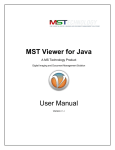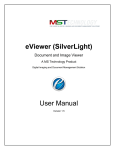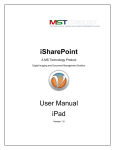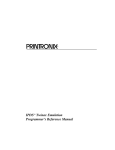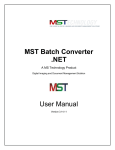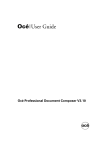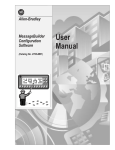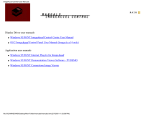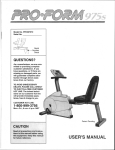Download MST Viewer for .NET User Manual
Transcript
MST Viewer for .NET A MS Technology Product Digital Imaging and Document Management Solution User Manual Version 14.10.05 MST Viewer Licensing and Copyright Information The software described in this guide is furnished under license agreement and is used in terms of accordance only. Product Version: MST Viewer v 14.10.48 Document Version: 14.10.05 Copyright © 2012 MS Technology. All rights reserved. This guide and accompanying software are confidential and proprietary to MS Technology. No part of this document is reproduced in any form by any means without prior authorization of MS Technology. The information provided in this document is used as a guide only and is subject to change without any notice. MS Technology reserves the rights to change and update their product or make changes in the context without any obligation to notify any person for such changes. MS Technology, P.O. Box 471843 Charlotte, NC 28247 USA Tel: 704-544-3403 Fax: 704-544-0262 Email: [email protected] Website: www.ms-technology.com If you find a typographical error in this manual, or if you have thought of a way to make this manual better, we would love to hear from you, feel free to share with us at [email protected]. User Manual Document Version: 14.10.05 2 MST Viewer Table of Contents 1. 2. Getting Started...................................................................................................................................... 5 1.1 Brief about User Guide ................................................................................................................. 5 1.2 Overview ....................................................................................................................................... 5 1.3 Need of the Product ...................................................................................................................... 5 1.4 Features ........................................................................................................................................ 5 1.5 Benefits ......................................................................................................................................... 7 1.6 Supported File Formats ................................................................................................................. 7 1.7 Compression Types ....................................................................................................................... 8 Install and Uninstall............................................................................................................................... 8 2.1 System Requirements ................................................................................................................... 8 2.2 Install the Software ....................................................................................................................... 8 2.3 Uninstall the Software ................................................................................................................ 11 3. Understanding Interface ..................................................................................................................... 13 4. Common Tasks .................................................................................................................................... 19 5. 4.1 Open Document .......................................................................................................................... 19 4.2 Working with Working Set .......................................................................................................... 20 4.3 Open Document in a Working Set .............................................................................................. 21 4.4 Append Document in a Working Set........................................................................................... 21 4.5 Save Document ........................................................................................................................... 21 4.6 Print Document ........................................................................................................................... 22 4.7 Scan Document ........................................................................................................................... 24 4.8 Send Document via Mail ............................................................................................................. 26 4.9 Fax Document ............................................................................................................................. 27 4.10 Add Watermark........................................................................................................................... 27 4.11 Customizing Toolbars/Buttons.................................................................................................... 28 4.12 Setting Default Properties........................................................................................................... 30 4.13 Setting Display Properties ........................................................................................................... 32 Annotation .......................................................................................................................................... 33 5.1 Line .............................................................................................................................................. 33 User Manual Document Version: 14.10.05 3 MST Viewer 5.2 Rectangle..................................................................................................................................... 34 6. 5.3 Circle ........................................................................................................................................... 35 5.4 Arrow .......................................................................................................................................... 36 5.5 Highlighter................................................................................................................................... 37 5.6 Pen .............................................................................................................................................. 38 5.7 Text ............................................................................................................................................. 39 5.8 Stamp .......................................................................................................................................... 40 5.9 Sticky Note .................................................................................................................................. 43 5.10 Mask ............................................................................................................................................ 44 5.11 Setting Priority to Annotations ................................................................................................... 45 5.12 Making Annotations Permanent ................................................................................................. 45 Short Cut Keys ..................................................................................................................................... 45 User Manual Document Version: 14.10.05 4 MST Viewer 1. Getting Started This section lets you get acquainted with various sections covered in this user manual which further helps you in understanding the product in a better and complete way. This user guide also contains key features with the system requirements for proper installation and use of product. 1.1 Brief about User Guide Welcome to the user guide of the MST Viewer. This user guide has been designed in such a way that the user is able to understand the software in an efficient and effective manner. So we recommend you to carefully go through the user guide before launching the product and keep it in a safe, easily accessible place for future reference. 1.2 Overview MST Viewer is a powerful and robust document viewing solution that allows users to view images and documents located in their Enterprise Content Management (ECM) system. Its main function is to render file formats including PDF, TIFF, JPEG, BMP, PNG, MS Office files, IBM proprietary file formats, CAD, and many others. It also allows users to manipulate, redact, annotate, create, and print documents and images stored in your ECM repository. 1.3 Need of the Product There is no other advanced viewer available in the market that handles all standard image file formats (JPEG, bitmap, TIFF files, etc.), MS Office, CAD most importantly IBM proprietary file formats and PDF, with the number of advanced features. MST Viewer can also be customized to fit your exact requirements. 1.4 Features MST Viewer is loaded with rich features that make it complete and outstanding. The following are some of the features of the viewer: User Interface options: Resizable, free floating window Thumbnail image selection File menu image selection Customize to support corporate branding using your logo, colors, and labels Customizable toolbar, add remove buttons at runtime Document Info. at status bar Splitter Panes Tree View (for quickly browsing through the documents) User Manual Document Version: 14.10.05 5 MST Viewer User Friendly User Interface Viewing Images: Auto detection of image formats View images and documents from your local hard drive or network Streamed image display avoids dead time when downloading new images Multiple page support Ultra fast image display, zooming, scrolling, rotation Fit to height or width Rotation in 90 degree increments Thumbnails Aspect ratio correction Pan button Working Set / Multi-Part Document Support Create and Annotate: Create new documents easily using cut, copy, paste, merge, and save functionality Annotate ANY format supported and save the document with annotations without modifying the original document. Draw freehand or use standard annotation shapes Insert bitmaps Merge the annotation with the image Ability to resize objects and the annotation will remain linked with the underlying image Rotate annotation data Add sticky notes with text edit capability Manipulation: Crop, paste, merge, and save Image Cleanup Image Enhance Scale-to-gray resizing for 1bit images Bilinear Interpolation for resizing Bi-Level images Bi-Cubic Interpolation for resizing color images Printing High resolution printing (300, 600, 1200 dpi) Print Selected Area User Manual Document Version: 14.10.05 6 MST Viewer Saving (Saving to multiple formats) PDF JPEG TIFF MODCA IOCA BMP GIF 1.5 Benefits MST Viewer provides benefits in a variety of following ways: Reduce Overhead and Increase Productivity: Allows companies to reduce a number of applications to one efficient universal document and image viewer. File Formats: Supports over 75 common and proprietary file formats. Email and Fax: Email and/or fax images and documents directly from MST Viewer application. Annotations: Access to a number of different annotations including, but not limited to redaction, line, arrow, rectangle, circle, text, note, highlighter, pen stamp, watermark and eraser. Internal Development: All file formats are developed by in-house MST developers and do not use any third party APIs. This gives you the ability to have customization, prompt resolutions to issues, and release control. Individual Release Control: Reduces deployment and upgrade cost. Every customer has their own release version of the product. 1.6 Supported File Formats MST Viewer supports the following file formats: TIFF JPEG PNG BMP GIF JFIF PCX DCX JPEG 2000 Sun Raster Formats User Manual Document Version: 14.10.05 MS Office: (Word, Excel, PowerPoint) IBM: (MO:DCA, IOCA, PTOCA) PDF Email: (MSG, EML) CAD: DWG, DXF WBMP ASCII PPM PGM PBM RTF 7 MST Viewer 1.7 Compression Types MST Viewer supports following compression types: Run Length Encoding (RLE) G3 (CCITT Fax 3) Modified G3 (Huffman) G4 (CCITT Fax 4) LZW Packed Bits JPEG ABIC IBM MMR 2. Install and Uninstall This section provides the minimal configuration needed to begin with the installation process and also guides on how to install and uninstall the product. 2.1 System Requirements Before continuing further with the installation, please make sure you have the minimum system requirements as specified below: Windows XP or higher Minimum 512 MB RAM 50 MB available hard disk 2.2 Install the Software Before you start installing MST Viewer, make sure that software installer file is available on the computer. Perform the following steps to install the software: 1. Double click on the setup.exe. 2. The MST Viewer Setup Wizard is displayed. User Manual Document Version: 14.10.05 8 MST Viewer 3. Click Next. The Select Installation Folder screen is displayed. 4. At the 'Select Installation Folder' screen, either browse to the location where you would like to save the program or allow at the default location. Also, indicate whether you want the software to be accessible to 'Everyone' or 'Just me'. ‘Everyone’ option means that all user accounts on the computer will have access to the software. ‘Just me’ option means that software will install and available to your user account only. It is advisable to select ‘Just Me’ option. 5. Click Next. The Confirm Installation screen appears. User Manual Document Version: 14.10.05 9 MST Viewer 6. Click Next. 7. The setup starts installing the software. 8. Wait until the setup completes its installation. 9. Once done, click Next. The Installation Complete screen appears. User Manual Document Version: 14.10.05 10 MST Viewer 10. Click Close. MST Viewer has been successfully installed on the system. 2.3 Uninstall the Software MST Viewer can be removed from the computer if you no longer need it and can be uninstalled by using one of the following method, both located on the Start menu: Uninstall from All Programs List Uninstall from Control Panel Before uninstalling MST Viewer, make sure that it is not running. Uninstall from All Programs List Perform the following steps to remove MST Viewer that is installed on the system through All Programs List: 1. 2. 3. 4. Click Start > All Programs > MST Viewer > Uninstall. A message is displayed asking your confirmation to remove the software. Click Yes. A progress bar appears that will safely remove the software. MST Viewer has been successfully uninstalled from the system. User Manual Document Version: 14.10.05 11 MST Viewer Uninstall from Control Panel Perform the following steps to remove MST Viewer that is installed on the system through Control Panel: 1. Click Start > Control Panel and then do one of the following: Windows 7 or Vista users: Click Programs and Features. Windows XP users: Click Add or Remove Programs. 2. It may take a bit of time to populate the long alphabetical list of programs installed on the system. 3. Select MST Viewer and then do one of the following: Windows 7 or Vista users: Click Uninstall. Windows XP users: Click Change/Remove button (to the right of the program). 4. A confirmation message is displayed asking your confirmation to uninstall the software. 5. Click Yes. MST Viewer has been successfully removed from the system. User Manual Document Version: 14.10.05 12 MST Viewer 3. Understanding Interface A user interface is the means by which you are able to communicate with the application. MST Viewer interface is user friendly and provide quick access to all important functions. Toolbar Menu Bar Thumbnail View Document View Area The following are the components in the application user interface. Menu Bar: It is the top most bar of the application interface that contains all the available features of the application. It has seven menu options: File Menu Edit Menu View Menu Image Menu Annotation Menu Window Menu Help Menu User Manual Document Version: 14.10.05 13 MST Viewer Menu File User Manual Document Version: 14.10.05 Options Options Description Open: Opens a previously saved file or document. Open Working Set: Opens documents in a Working Set Append in Working Set: Appends multiple documents in an opened Working Set New Working Set: Creates a new Working Set Scan Document: Scan a document Fax Document: Fax a document Send Document: Send any document to other person via mail Close: Closes an active document but does not quit application Close All: Closes all opened documents Save: Saves an active document with its current filename and location Export: Saves an active document to another location with the same or different filename Print: Prints an active document Print Selected Area: Prints the selected portion of an active document Print Preview: Shows how the file will look when you print it Print Setup: Shows various printing options such as paper size, orientation, etc. Print Configure: Shows configuration settings of the printer Exit: Closes all opened documents and quit application 14 MST Viewer Edit View User Manual Document Version: 14.10.05 Cut: Cuts the selected text or image or annotation from a page Copy: Copies the selected text or image or annotation from a page Paste: Inserts the copied text or image or annotation at the insertion point (cursor) Delete Selected: Delete selected file or document Re-Order Pages: Assigns the order of the pages in a document Close Document: Closes an active document in a Working Set Delete Document: Deletes selected document from the Working Set Delete All Documents: Deletes all opened document from the Working Set but does not quit application Select All Pages: Selects all pages of a document in a Working Set Deselect All Pages: Deselect all the selected pages of a document First Page: Display the first page of an active document Previous Page: Display the previous page of an active document Next Page: Display the next page of an active document Last Page: Display the last page of an active document Go To Page: Go to the specified page of a document First Document: Display the first page of the first document opened in a Working Set Prev Document: Display the previous document opened in a Working Set Next Document: Display the first page of a next document opened in a Working Set Last Document: Display the first page of the last document opened in a Working Set Status Bar: Displays the status bar Tree View: Displays the tree view of 15 MST Viewer Image User Manual Document Version: 14.10.05 the document opened in a Working Set Thumbnails: Displays the thumbnail view of the documents opened in a Working Set Hide Annotations: Allows you to toggle the visibility of individual annotations Ruler: Displays ruler on the file Auto Resize: Resize the file or document either vertically or horizontally Enhance: Enhances a page of a document Zoom In: Increases the magnification percentage of an active document Zoom Out: Decreases the magnification percentage of an active document Custom Zoom: Resize the document with a specified size Actual Size: Bring the document in its actual size Fit in Window: Resize the document to fit entirely in the window Fit To Width: Resize the document to fit the width of the window Fit to Height: Resize the document to fit the height of the window Rotate Right: Rotate the page of an active document in a clockwise direction Rotate Left: Rotate the page of an active document in an counterclockwise direction Rotate 180: Rotate the page of an active document in a 180° direction WaterMark: Inserts a watermark in an active document Invert: Invert the color of an active page Magnifying Lens: Magnifies a specific part of an image Image Properties: Displays properties of an image Copy Image to Clipboard: Copies images of an active document to 16 MST Viewer Window Help clipboard Copy Text to Clipboard: Copy selected text of an active document to clipboard New Window: Opens another window with a copy of active documents Cascade: Arrange (open windows) in such a way so that they overlap each other, with the title bars visible Open Documents List: Displays list of all opened documents. An active document has a check mark besides it. Help: Open user manual for assistance About MST Viewer: Check the product version and licensing information Toolbar: Frequently accessing tools through the menu bar is little bit clumsy. MST Viewer has floating toolbars with several buttons that can be easily access to quickly perform any action. The toolbars can be dragged to any location so as not to hinder the view of the document. If too many toolbars are visible, then they can be temporarily hide by View -> Toolbars. User Manual Document Version: 14.10.05 17 MST Viewer There are 5 toolbars available: 1. Standard Toolbar Open Document Open Working Set Append in Working Set Save Document New Document Print Document Close All Documents Save As Close Document Custom Zoom Rotate Left Help Scroll Document 2. Image Features Toolbar Zoom Out Normal Rotate Right Zoom In Fit To Window Rotate 180 Window Width Window Length Invert Image 3. Page Navigation Toolbar First Document 4. Annotation Toolbar Line Last Document Previous Document Circle Rectangle Text Highlight Arrow Pen Next Document Sticky Note Stamp Show/Hide Annotation Eraser Bring To Front Sent to Back 5. Document Navigation Toolbar First Page Previous Page User Manual Document Version: 14.10.05 Last Page Next Page 18 MST Viewer 4. Common Tasks This section lists some common operations that can be performed while managing the MST Viewer. 4.1 Open Document The document can be opened in the MST Viewer in two ways: Using Menu Using Icon Open a Document Using Menu Perform the following steps to open a document using menu option: 1. 2. 3. 4. 5. On the File menu, click Open. The Open Dialog box is displayed. Navigate and find the file to open. Once you found it, select it and click Open. If the selected file is supported will be opened in the application. Open a Document Using Icon Perform the following steps to open a document using icon: 1. Click Open button displayed on the Standard toolbar. 2. 3. 4. 5. The Open Dialog box is displayed. Navigate and find the file to open. Once you found it, select it and click Open. If the selected file is supported will be opened in the application. To open multiple documents, press CTRL key and select multiple documents. User Manual Document Version: 14.10.05 19 MST Viewer 4.2 Working with Working Set Working Set is a collection of documents. With the help of Working Set, you can: View multiple documents in a single document window. Browse documents and pages from Tree View or Thumbnail. Scan documents and add them on working set. Create custom documents in a working set which can be converted to single or multi-page documents. Document No. Page No. for a Working Set Working Set Currently Selected Document User Manual Document Version: 14.10.05 20 MST Viewer 4.3 Open Document in a Working Set In a working set, one or more documents can be opened in a tree view or thumbnail view by performing the following steps: 1. On the File menu, click Open Working Set OR click the Open Working Set button displayed on the Standard toolbar. 2. The Open Working Set dialog box is displayed. 3. Navigate and find the file to open. 4. Once you found it, select it and click Open. 5. If the selected file is supported will be opened in the application. 4.4 Append Document in a Working Set In a working set, multiple documents can be appended by performing the following steps: 1. On the File menu, click Append in Working Set or click the Append in Working Set button displayed on the Standard toolbar. 2. The Append in Working Set dialog box is displayed. 3. Navigate and find the file to append. 4. Once you found it, select it and click Open. 5. If the selected file is supported will be opened in the application. 6. Repeat the process to append multiple documents. 4.5 Save Document The document can be saved in one of the several formats to the user’s workstation or to a folder on a network drive. MST Viewer supports saving files to the following formats: Plain Text (ASCII) TIFF JPEG GIF Bitmap MODCA IOCA PDF Perform the following steps to save a document: 1. On the File menu, click Save OR click the Save button displayed on the Standard toolbar. Perform the following steps to save a document in a different format: User Manual Document Version: 14.10.05 21 MST Viewer 1. Click Save As button displayed on the Standard toolbar 2. The Export dialog box is displayed. 3. In the navigation pane (the left pane), select the folder in which you want to save the file and navigate to the path. 4. In File Name box, enter the name of the file. 5. In Select as type drop down box, select the format in which you want to save the file. 6. Select the required option from the list of available save options: Current Page: To save the current page only. Current Document: To save all pages of the current document. Pages: To save some specified pages, then enter the page numbers using arrow keys. 7. 8. 9. 10. 4.6 Click on Save Annotation checkbox if you want to save annotation made in the file. Click on Save Watermark checkbox if you want to save watermark created in the file. Once done, click Save. The document has been successfully saved in a different format. Print Document The document can be printed by performing the following steps: 1. Open the document that you want to print. 2. On the File menu, click Print. 3. The Print dialog box is displayed. User Manual Document Version: 14.10.05 22 MST Viewer 4. Under Printer group, select the printer you want to use (if it is not selected). 5. Under Print Range group, specify the portion of the document that you want to print. If you click Pages, you have to enter the page numbers or page ranges you want to include. 6. Under Copies group, select the number of copies that you want to print. 7. Once done, click OK. To print selected area: 1. 2. 3. 4. 5. 6. 7. Open the document that you want to print. If you want to print only a part of the document, select the desired portion of the document. On the File menu, click Print Selected Area. The Print dialog box is displayed. Under Printer group, select the printer you want to use (if it is not selected). Under Copies group, select the number of copies that you want to print. Once done, click OK. To see how your document looks before you print it, go to the File menu and select Print Preview. This will generate a preview of how your document will look like when it's printed on paper. To adjust Printer Settings: 1. 2. 3. 4. 5. Open the document that you want to print. On the File menu, click Print Setup. The Print Setup dialog box is displayed. Select the printer you want to use (if it is not selected) under Printer group. Under Paper group, select the paper size in Size drop down box. This drop down box lists the paper sizes supported by the current printer as well as industry standard sizes. 6. Under Orientation group, specify the paper orientation as portrait or landscape. 7. If the printer is available on the network, click on the Network button and connect the printer. 8. Once done, click OK. User Manual Document Version: 14.10.05 23 MST Viewer 4.7 Scan Document MST Viewer provides a functionality through which documents, images or any other file can be scanned and can be viewed in a viewer. Perform the following steps to scan document: 1. On the File menu, click Scan Document. 2. The MSTScanner (Select Source) is displayed. 3. Under Select Source, select the device for scanning document. 4. Select the required option from Default Level or Custom Level. If Default Level is set, the application will scan document with default resolution, scaling and pixel type. If Custom Level is set, the application provides options to specify resolution, scaling and pixel type. 5. Once done, click Next. 6. The application starts scanning the document. 7. Wait until application scans document successfully. 8. Once the image has been scanned, a small thumbnail preview will be displayed in MSTScanner (Preview) dialog box with following four options: User Manual Document Version: 14.10.05 24 MST Viewer Preview: Scans other document without adding the currently scanned image to the Working Set. Next: Add currently scanned image to the Working Set and scans another continuing the same session (using the same device and settings). Cancel: Discard currently scanned image and return to the application, closing the current session. Finish: Add currently scanned image to the Working Set and return to the application, closing the current session. User Manual Document Version: 14.10.05 25 MST Viewer 4.8 Send Document via Mail MST Viewer provides a functionality through which scanned documents, images, annotated file, or any other type of file can be send to any person via email. Perform the following steps to send a document. 1. On the File menu, click Send Document. 2. The Send Email dialog box is displayed. 3. Enter details in the respective fields. 4. Once done, click Send. 5. The email has been sent to the selected recipients successfully. User Manual Document Version: 14.10.05 26 MST Viewer 4.9 Fax Document MST Viewer provides a functionality through which scanned documents, images, annotated file, or any other type of file can be fax instantly. Simply provide the recipients fax number, that’s it. Perform the following steps to fax any document. 1. On the File menu, click Fax Document. 2. The MST Fax Wizard dialog box is displayed. 3. 4. 5. 6. 7. Enter the name of the document in Document Name text box field. Enter the details of the sender in Sender’s Details group box. Enter the details of the recipient in Receiver’s Details group box. Once done, click OK. The document has been faxed to the selected recipient successfully. 4.10 Add Watermark A watermark is a visible embedded overlay that enhances the appearance of document by adding an image or text that identifies document contents as confidential information. It is used to print text or graphic behind document text. Watermarks are transparent, and therefore any text or object printed over a watermark is clearly visible. Perform the following steps to insert watermark: 1. On the Image menu, click Watermark. 2. The MSTViewer Watermark dialog box is displayed. User Manual Document Version: 14.10.05 27 MST Viewer 3. 4. 5. 6. 7. 8. 9. 10. 11. Enter the text in Text field. Select the formatting options in Font field. Select the transparency by dragging the slider in Opacity group. Rotate the text by dragging the slider in Rotate By field. Select the alignment option from the Align Text drop down box. Click on Set as Default button to make existing property values as default values. Click on Restore Default button to restore default properties. Once done, click OK. The watermark has been inserted to the document successfully. 4.11 Customizing Toolbars/Buttons The toolbars can be shown or hidden and will display exactly the items depending upon your needs. Perform the following steps to customize toolbar: 1. On the File menu, click Preferences. 2. The Configuration dialog box is displayed. 3. Go to the required tab and configure the toolbar by doing any of the following: To view toolbar: Click View Toolbar checkbox to view toolbar. To add items to the toolbar: Select the items by clicking on the checkboxes under Select Icons group box that you want to appear in the toolbar. To remove items from the toolbar: Deselect the items by clicking on the checkboxes under Select Icons group box to remove from the toolbar. 4. When you finished configuring the toolbar, click OK. 5. Restart the application so as to make changes effective in the application. User Manual Document Version: 14.10.05 28 MST Viewer Disabled toolbars will not appear in any way in the viewer. Disabled icons will not appear in the toolbar in any way in the viewer. Toolbar settings maintained in Preferences will persist next time when the viewer is opened. User Manual Document Version: 14.10.05 29 MST Viewer 4.12 Setting Default Properties Default properties are the standard options that are automatically set and can be changed depending upon your needs. If changes are made, then the application will apply those changes and will remember as a default setting for the working area. Perform the following steps to set default properties for the viewer: 1. On the File menu, click Preferences. 2. The Configuration dialog box is displayed. 3. Click User Options tab. User Manual Document Version: 14.10.05 30 MST Viewer Field Name Enable scale to gray Field Description To enhance an image. If unchecked, Enhanced option is disabled in Image menu Maximize window when displaying the Opens document in a maximized window document Create enhanced thumbnail by default Enhances thumbnail images Close Viewer (After Save) Closes viewer after saving changes Annotations are visible while being moved Will display all annotation on the document clearly while moving Immediately display changes made in Reflect changes (color change, etc.) made in annotation property dialogs to the selected the annotation property dialog box before annotations clicking OK button. If unchecked, then changes will be reflected after clicking OK button Hide annotation Hides all annotations Keep selected Selected annotation will remain active until and unless we click on normal icon Trace enabled Size of the log file Toolbar placement Location where the toolbar is to be placed – top, bottom, left, right Temporary Documents Path Path where the documents are stored Temporary Logs Path Path where the log files are stored 4. Select or unselect the required options depending upon your needs. 5. Once done, click OK. 6. The default properties have been saved successfully. User Manual Document Version: 14.10.05 31 MST Viewer 4.13 Setting Display Properties The display properties can be set for the viewer by performing the following steps: 1. On the File menu, click Preferences. 2. The Configuration dialog box is displayed. 3. Click Display Options tab. Field Name Foreground color Background color Default display of image Percentage of zoom change Plain text page width (columns) Plain text page height (rows) User Manual Document Version: 14.10.05 Field Description To change the color of the text To change the background color of an image Size of an image as compared to its original size Percentage in the magnification of an image every time you zoom it Number of columns to display in a text file. The size ranges from 100 to 2200 Number of rows to display in a text file. The size ranges from 100 to 2200 32 MST Viewer Display the inverted image Default Rotation Apply zoom across all pages Inverts the color of the displayed image Rotate an image at 0°, 90°, 180°, 270° with respect to the actual image position Set all pages with same magnification 4. Select or unselect the required options depending upon your needs. 5. Once done, click OK. 6. The modified changes will reflect when you reopen the document again. 5. Annotation Annotations are comments, notes, explanations, or other types of external remarks that can be added to a selected part of the document to explain or illustrate its meaning. MST Viewer provides tools to enable you to freely write your own comments to the document and can share with others. It provides facility to add comments via sticky notes, apply digital stamps and much more thus making MST Viewer an ideal solution for business work flow. It also allows you to save, copy, paste and print annotation and contents. Annotation marks are saved within a MO:DCA image file as annotation data that is kept separate from the image data. Whenever we make some annotations, a file with the same name with an extension .t_l is created in the current directory. Any annotation that is NOT burned-in (embedded) is put in this file. These marks can also be merged with the image data in a process known as burning-in. To save annotations to any file type other than MO:DCA or TIFF, we save .t_l file. The .t_l file is a GOCA file. Once annotations are burned-in a MO:DCA document, they become part of the base image but still can be manipulated by the annotation functions. MST Viewer has a full range of annotation tools. Following is a list of the annotation and markup tools included in MST Viewer, with a brief description of their functionality. 5.1 Line This annotation tool draws a horizontal, vertical, or lines at 45° with adjustments: color, thickness, and transparency. Perform the following steps to draw a line: 1. On the Annotation menu, click Line OR click on the Line icon from the Annotation toolbar OR use shortcut key CTRL + ALT + L. 2. Click where you want the line to begin, and then drag the mouse to the place where it should end, and release the mouse button. User Manual Document Version: 14.10.05 33 MST Viewer Edit Properties of Line 1. Select the annotation. 2. Right click and click Properties. 3. The Line Properties dialog box is displayed. 4. To change the color of the line: Click on the Line color button. The color palette is displayed. Select the required color. 5. To change the width of the line: Enter the required value in Line Width text box OR maximize or minimize the up or down arrows. 6. Click on the Transparent checkbox to make line transparent. 7. Click on Set as defaults button to make existing property values as default values. 8. Click on Restore defaults button to restore default properties. 9. Once you finished, click OK. 5.2 Rectangle This annotation tool draws a rectangle with adjustments: line and fill color, thickness, and transparency. Perform the following steps to draw a rectangle: 1. On the Annotation menu, click Rectangle OR click on the Rectangle icon from the Annotation toolbar OR use shortcut key CTRL + ALT + R. 2. Click on the screen and drag diagonally and release the mouse button. Edit Properties of Rectangle 1. Select the annotation. 2. Right click and click Properties. 3. The Rectangle Properties dialog box is displayed. User Manual Document Version: 14.10.05 34 MST Viewer 4. To change the color of the border of the rectangle: Click on the Border color button. The color palette is displayed. Select the required color. 5. To change the width of the rectangle: Enter the required value in Border Width text box OR maximize or minimize the up or down arrows. 6. To fill color inside the rectangle: Click on the Fill color button. The color palette is displayed. Select the required color. 7. Click on the transparent checkbox to make rectangle transparent. 8. Click on Set as defaults button to make existing property values as default values. 9. Click on Restore defaults button to restore default properties. 10. Once you finished, click OK. 5.3 Circle This annotation tool draws a circle with adjustments: line and fill color, thickness, and transparency. Perform the following steps to draw a circle: 1. On the Annotation menu, click Circle OR click on the Circle icon from the Annotation toolbar OR use shortcut key CTRL + ALT + C. 2. Click on the screen and drag diagonally and release the mouse button. Edit Properties of Circle 1. Select the annotation. 2. Right click and click Properties. 3. The Circle Properties dialog box is displayed. User Manual Document Version: 14.10.05 35 MST Viewer 4. To change the color of the border of the circle: Click on the Border color button. The color palette is displayed. Select the required color. 5. To change the width of the circle: Enter the required value in Border Width text box OR maximize or minimize the up or down arrows. 6. To fill color inside the circle: Click on the Fill color button. The color palette is displayed. Select the required color. 7. Click on the Transparent checkbox to make circle transparent. 8. Click on Set as defaults button to make existing property values as default values. 9. Click on Restore defaults button to restore default properties. 10. Once you finished, click OK. 5.4 Arrow This annotation tool draws a horizontal, vertical or 45° arrow with adjustments: color, thickness, arrowhead length and angle. Perform the following steps to draw an arrow: 1. On the Annotation menu, click Arrow OR click on the Arrow icon from the Annotation toolbar OR use shortcut key CTRL + ALT + A. 2. Click where you want the arrow to begin, and then drag the mouse to the place where it should end, and release the mouse button. Edit Properties of Arrow 1. Select the annotation. 2. Right click and click Properties. 3. The Arrow Properties dialog box is displayed. User Manual Document Version: 14.10.05 36 MST Viewer 4. To change the color of an arrow: Click on the Arrow color button. The color palette is displayed. Select the required color. 5. To change the width of an arrow: Enter the required value in Line Width text box OR maximize or minimize the up or down arrows. 6. To set arrowhead length and angle: Enter the required value in Arrowhead length and Arrowhead angle text box OR maximize or minimize the up or down arrows. 7. Click on the Transparent checkbox to make arrow transparent. 8. Click on Set as defaults button to make existing property values as default values. 9. Click on Restore defaults button to restore default properties. 10. Once you finished, click OK. 5.5 Highlighter People use creative methods to draw attention to items of interest when they mark up a paper document, such as underlining, highlighting, circling words in a sentence. This annotation tool provides a similar feature for marking up information displayed in the viewer. Perform the following steps to draw highlighter: 1. On the Annotation menu, click Highlighter OR click on the Highlight icon from the Annotation toolbar OR use shortcut key CTRL + ALT + H. 2. Click on the screen and drag diagonally and release the mouse button. Edit Properties of Highlighter 1. Select the annotation. 2. Right click and click Properties. 3. The Highlighter Properties dialog box is displayed. User Manual Document Version: 14.10.05 37 MST Viewer 4. To fill color inside highlighter: Click on the Fill color button. The color palette is displayed. Select the required color. 5. Click on Set as defaults button to make existing property values as default values. 6. Click on Restore defaults button to restore default properties. 7. Once you finished, click OK. 5.6 Pen This annotation tool draws freehand lines and shapes with adjustments: color, thickness, and transparency. Perform the following steps to draw a freehand line: 1. On the Annotation menu, click Pen OR click on the Pen icon from the Annotation toolbar OR use shortcut key CTRL + ALT + P. 2. Click on the screen and drag the mouse. The line will follow your mouse moves. Release the mouse button to end your drawing. Edit Properties of Pen 1. Select the annotation. 2. Right click and click Properties. 3. The Pen Properties dialog box is displayed. User Manual Document Version: 14.10.05 38 MST Viewer 4. To change the color of freehand line: Click on the Line color button. The color palette is displayed. Select the required color. 5. To change the width of freehand line: Enter the required value in Line Width text box OR maximize or minimize the up or down arrows. 6. Click on the Transparent checkbox to make freehand line transparent. 7. Click on Set as defaults button to make existing property values as default values. 8. Click on Restore defaults button to restore default properties. 9. Once you finished, click OK. 5.7 Text This annotation tool enters text with adjustments: size and color of the fonts and the text box. Perform the following steps to add any text: 1. On the Annotation menu, click Text OR click on the Text icon from the Annotation toolbar OR use shortcut key CTRL + ALT + T. 2. A cursor will appear on the screen allowing you to type in text. 3. To finish editing the text, click anywhere outside of the text box. 4. To edit the text later, just click on the text. A border with selection handles will appear. The text box can be repositioned by dragging the text box border and the size of the text box can be adjusted by dragging the selection handles. Edit Properties of Text 1. Select the annotation. 2. Right click and click Properties. 3. The Text Settings dialog box is displayed. 4. To change the color of the text: Click on the Text color button. The color palette is displayed. Select the required color. User Manual Document Version: 14.10.05 39 MST Viewer 5. To fill color in the text box: Click on the Fill color button. The color palette is displayed. Select the required color. 6. To change the formatting of text: Click on the Font button. The font dialog box is displayed. Make required formatting changes. 7. To edit the text: Edit the existing text in the Text box. 8. Click on the Transparent checkbox to make text transparent. 9. To rotate text with image: Click on the Rotate with Image checkbox option if you want to rotate text along with an image. 10. Click on Set as Defaults button to make existing property values as default values. 11. Click on Restore Defaults button to restore default properties. 12. Once you finished, click OK. 5.8 Stamp Just as you would use a rubber stamp, you can stamp images and text anywhere on a document. You can choose either from a list of pre-defined stamps or create your own stamps. Perform the following steps to add stamp: 1. On the Annotation menu, click Stamp OR click on the Stamp icon from the Annotation toolbar OR use shortcut key CTRL + ALT + S. 2. Click where you want to place the stamp. Edit Properties of Stamp 1. Select the annotation. 2. Right click and click Properties. 3. The Stamp Properties dialog box is displayed. 4. To change the color of the stamp: Click on the Border and text color button. The color palette is displayed. Select the required color. User Manual Document Version: 14.10.05 40 MST Viewer 5. To adjust thickness of the stamp: Enter the required value in the Border width text box OR minimize or maximize the up and down arrows. 6. To fill color in the stamp: Click on the Fill color button. The color palette is displayed. Select the required color. 7. To change the angle of the stamp: Enter the required value in Angle text box OR minimize or maximize the up and down arrows. 8. To change the formatting of stamp: Click on the Font button. The font dialog box is displayed. Make required formatting changes. 9. To edit the text of the stamp: Edit the existing text of the stamp in the Text box OR click on the Edit name button. Clicking the button will take the cursor to Text box. 10. To display image in a stamp: Click on Image radio button. Click on Image button. The Select Stamp Image dialog box is displayed. Click on Browse button and navigate to the image that you want to display. Adjust the height and width of the image in Resize group box. Once done, click OK. 11. Click on the Transparent checkbox to make text transparent. 12. Click on Set as Defaults button to make existing property values as default values. 13. Click on Restore Defaults button to restore default properties. 14. Once you finished, click OK. As you change the properties of stamp, it will be reflected in Preview section. To Create New Stamps All the existing stamps are located in the list of pre-defined stamps. If you want to add a specific stamp, then you can create a new stamp in MST Viewer. Perform the following steps to create a new stamp: 1. On the Annotation menu, click Stamp OR click on the Stamp icon from the Annotation toolbar OR use shortcut key CTRL + ALT + S. 2. Click where you want to place the stamp. 3. Select the annotation. 4. Right click and click Properties. 5. The Stamp Properties dialog box is displayed. 6. Click New Stamp button. 7. The New Stamp Properties button dialog box is displayed. User Manual Document Version: 14.10.05 41 MST Viewer 8. Under Frame Settings group box, for the new stamp, select the border and text color, thickness and angle in Border and text color, Border width and Angle fields respectively. 9. Under Fill Settings group box, if you want to fill the color inside the stamp then click on the button. The color palette is displayed. Select the required color. Click OK. Click on the Transparent checkbox to make stamp transparent. 10. Under Style group box, select from the available options the type of new stamp either Text or Image. For Text stamp, enter the name of the stamp in the text box. For Image stamp, click on Image button. The Select Stamp Image dialog box is displayed. Click on Browse button and navigate to the image that you want to display. Adjust the height and width of the image in Resize group box. Once done, click OK. 11. Click on the Font button to change formatting of text. 12. Once done, click OK. 13. The newly created stamp has been created and will be listed in the Stamps list box. 14. Select from the list of stamps the stamp that you want to stamp. 15. Click on Set as Defaults button to make newly created stamp as a default stamp. 16. Once done, click OK. User Manual Document Version: 14.10.05 42 MST Viewer Delete a Stamp: Perform the following steps to delete any existing or pre-defined stamps: 1. On the Annotation menu, click Stamp OR click on the Stamp icon from the Annotation toolbar OR use shortcut key CTRL + ALT + S. 2. Click where you want to place the stamp. 3. Select the annotation. 4. Right click and click Properties. 5. The Stamp Properties dialog box is displayed. 6. Select the stamp from the list of available stamps in Stamps group box. 7. Click Delete. 8. The selected stamp has been removed from the list of pre-defined stamps. You cannot delete all the stamps. There should be atleast one stamp be available in the list. 5.9 Sticky Note Sticky Note is quite similar to typical sticky note that is stuck with the hard copy documents. It is more efficient and provides a natural and familiar means by which you can add and share comments in the form of a note anywhere on a page over text, images or blank spaces without editing the content. Perform the following steps to add a sticky note: 1. On the Annotation menu, click Sticky Note OR click on the Sticky Note icon from the Annotation toolbar OR use shortcut key CTRL + ALT + N. 2. Click on the screen to stick down your note. 3. It will open a sticky note in edit mode. 4. Enter comments in the note. 5. Once done, click outside of the note to release from sticky note. Edit Properties of Sticky Note 1. Select the annotation. 2. Right click and click Properties. 3. The Sticky Note Properties dialog box is displayed. User Manual Document Version: 14.10.05 43 MST Viewer 4. To change the border and text color of the Sticky Note: Click on the Border and text color button. The color palette is displayed. Select the required color. 5. To adjust thickness of the Sticky Note: Enter the required value in the Border Width text box OR minimize or maximize the up and down arrows. 6. To fill color in the Sticky Note: Click on the Fill color button. The color palette is displayed. Select the required color. 7. To change the formatting of Sticky Note: Click on the Font button. The font dialog box is displayed. Make required formatting changes. 8. To edit the text of the Sticky Note: Edit the existing text of the Sticky Note in the Text box. 9. Click on the Transparent checkbox to make Sticky Note transparent. 10. Click on Set as Defaults button to make existing property values as default values. 11. Click on Restore Defaults button to restore default properties. 12. Once you finished, click OK. Sticky Notes can be shown, hidden or displayed as an icon on a page by selecting option Show Sticky Note from Annotation menu. 5.10 Mask This annotation tool is used to hide certain part of a file or document. Perform the following steps to draw mask: 1. On the Annotation menu, click Mask OR use shortcut key CTRL + ALT + M. 2. Click on the screen and drag diagonally and release the mouse button. User Manual Document Version: 14.10.05 44 MST Viewer 5.11 Setting Priority to Annotations The priority of the annotation on a document or a page can be set by performing the following steps: 1. Select annotation on a page. 2. To bring an image in front of annotation: Select Bring to Front option from Annotation menu. 3. To send an image at the back of annotation: Select Send to Back option from Annotation menu. 5.12 Making Annotations Permanent The annotations drawn on a document or a page can be set permanent by performing the following steps: 1. 2. 3. 4. Draw annotation(s) on a document or page. Select annotation(s) that you want to fix. Select Burn Annotation option from Annotation menu. The selected annotation has been fixed permanently i.e. they will not move now. 6. Short Cut Keys Short Cut keys provide an easier and quicker method of navigating and using software. Short Cut keys are commonly accessed by using ALT, CTRL, or SHIFT in conjunction with a single letter. As you begin to memorize shortcut keys, you'll notice that many applications share the same shortcut keys. The below basic shortcut keys are a listing of shortcut keys that will work with almost all IBM compatible computers and software programs. It is highly recommended that all users keep a good reference of the below shortcut keys or try to memorize the below keys. Doing so will dramatically increase your productivity. Command Open Close Close All Documents Save As Print Cut Copy Paste Insert Page Delete Selected Delete Document Delete All Document Select All Pages User Manual Document Version: 14.10.05 Short Cut Key Ctrl + O Ctrl + W Ctrl + Shift + W F12 Ctrl + P Ctrl + X Ctrl + C Ctrl + V Insert Delete Ctrl + Delete Ctrl + Shift + Delete Ctrl + Shift + A 45 MST Viewer Deselect All Pages Crop Page First Page Previous Page Last Page Next Page Go To Page First document Next Document Last Document Previous Document Thumbnails Hide Annotations Enhance Zoom In Zoom Out Custom Zoom Actual Size Fit in Window Fit to Width Fit to Height Rotate Right Rotate Left Rotate 180 Invert Magnifying Lens Image Properties Pen Highlighter Rectangle Circle Line Arrow Sticky Note Stamp Text User Manual Document Version: 14.10.05 Ctrl + Shift + D Ctrl + Shift + C Home Page Up End Page Down Ctrl + G F7 Ctrl + Page up Ctrl + Page Down F8 Ctrl + F11 F11 Ctrl + E + Ctrl + M Shift + A Shift + F Shift + W Shift + H Ctrl + Arrow Right Ctrl + Arrow Left Ctrl + Arrow Down Ctrl + Alt + I Alt + L Ctrl + Alt + Enter Ctrl + Alt + P Ctrl + Alt + H Ctrl + Alt + R Ctrl + Alt + C Ctrl + Alt + L Ctrl + Alt + A Ctrl + Alt + N Ctrl + Alt + S Ctrl + Alt + T 46














































